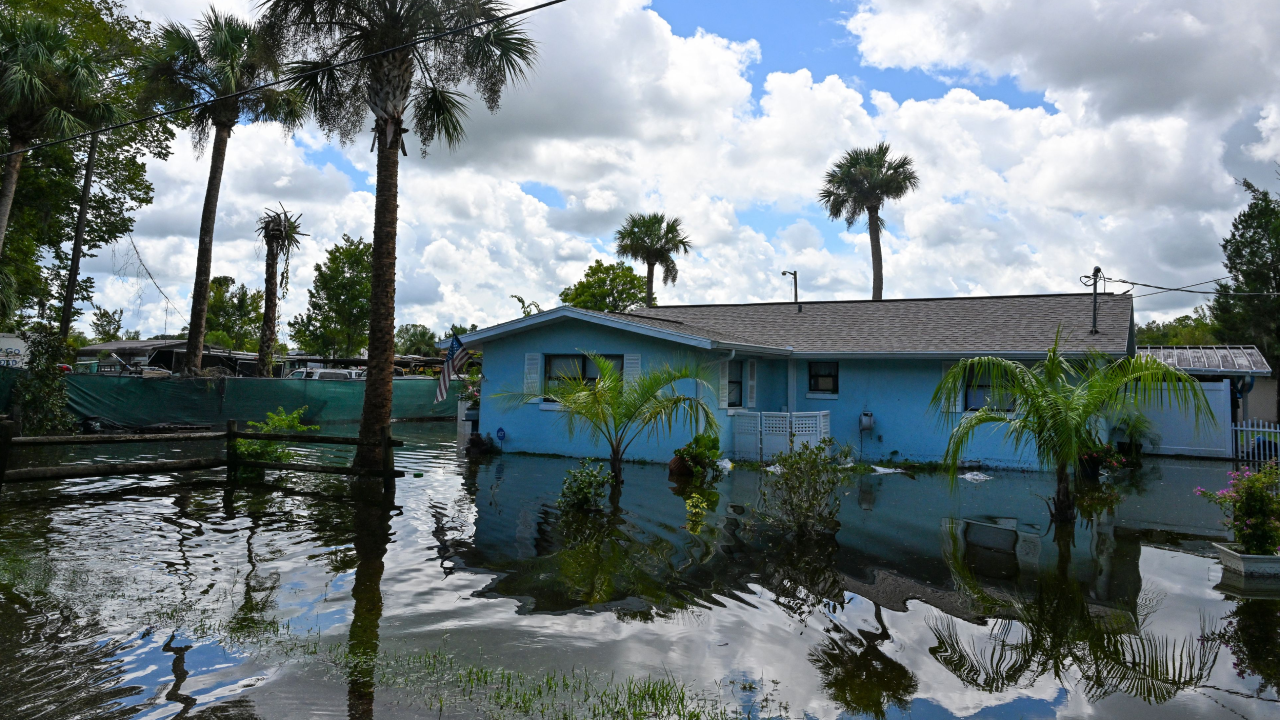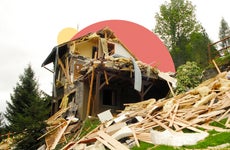The consequences of extreme weather on property values and pocketbooks

The Bankrate promise
At Bankrate we strive to help you make smarter financial decisions. While we adhere to strict , this post may contain references to products from our partners. Here's an explanation for .
Key takeaways
- Severe weather events, such as damaging storms, wildfires and extreme heat waves or droughts, are increasing across the country.
- These events create higher maintenance and insurance costs for homeowners, and they can have a dramatic effect on property values in high-risk areas.
- Energy-efficient upgrades and better disaster preparedness can help mitigate the risk, but implementing them can be expensive.
Real estate has been on a roller coaster ride over the past few years. With all the focus on the pandemic, skyrocketing rates and more, not much attention has been paid to the forecast — as in, the literal weather. But extreme weather and other natural disasters have a huge impact on homeowners. One hurricane or wildfire can reshape an entire housing market.
A recent report from Zillow shows that 83 percent of homebuyers consider climate risks such as floods, hurricanes, fires and droughts when they’re house hunting. And for existing homeowners, extreme weather is creating major money headaches: A new Bankrate survey found that more than half of Americans have had to pay extra costs due to an extreme weather event in the past decade. What will the next decade look like? Read on to understand how climate-related disasters impact rising home prices.
Extreme weather data and statistics
Bad weather is creating big problems everywhere. According to Karen Collins, vice president at the American Property Casualty Insurance Association (APCIA), losses from natural disasters totaled more than $275 billion over the past three years — the highest figure ever. And it’s not just the headline-making catastrophes: More everyday problems, like hail and wind damage, are also reaching new heights. “The secondary perils are increasingly contributing to annual insured losses, to a degree that is actually outpacing primarily perils [like hurricanes and earthquakes],” Collins says.
Here’s how property damage costs add up in different parts of the country, according to findings from Bankrate’s Severe Weather Financial Survey.
- 57 percent of people surveyed have incurred costs due to extreme weather in the past 10 years.
- 14 percent have incurred property damage expenses living in the Northeast.
- 25 percent have incurred property damage expenses living in the South.
- 20 percent have incurred property damage expenses living in the Midwest.
- 17 percent have incurred property damage expenses living in the West.
Rising real estate prices
If you’re looking to buy a home, you’ve probably crunched the numbers on how much you can afford to spend. Your budget will get you different kinds of properties depending on where you’re hoping to call home, and surprisingly, real estate prices have stayed resilient in some of the areas where extreme weather is a common concern. Consider Fort Myers, Florida, which suffered heavy damage during Hurricane Ian in September 2022: According to Redfin data, median home prices there actually increased by around 10 percent in the year following the storm.
What’s happening in the states that are best prepared for climate change, then? Despite their climate-resistance, they’re not pulling in the numbers that sunshine and beaches do. In Minnesota, for example, Redfin data shows that median prices have also increased over the past year, but only by only about 2 percent.
Regardless of rising home prices, extreme weather makes homeownership far more expensive in another way: maintaining and insuring your property. Some disaster-prone states, like Florida and California, have even seen big-name insurance companies withdraw from the market due to rising costs, which makes home affordability that much more challenging.
Natural disaster challenges and maintenance costs
For homeowners and hopeful buyers in coastal and flood-prone areas, it’s getting very difficult to find an insurance policy. “Homeowners-insurance carriers have become increasingly reluctant to write policies in coastal areas, due to the high risk of damage from natural disasters such as hurricanes, tropical storms and flooding,” says Loretta Worters, vice president of media relations at the Insurance Information Institute. “In recent years, the frequency and severity of these events have caused significant losses to insurance companies, leading many of them to pull back from offering coverage in coastal regions altogether.”
While Florida is a top state for relocation — it had a faster rate of population growth than any other state in the country last year, according to U.S. Census data — Redfin chief economist Daryl Fairweather believes that the influx of people may begin to slow. “I think Florida’s reign on our top migration list is going to end soon,” she says. “We’re hearing more and more from agents about how expensive insurance costs are making it really unaffordable to buy a home in Florida, on top of high mortgage rates and high prices.”
Data from the APCIA shows that those woes seem likely to hit other areas soon, too. In Texas, for example, insurers have paid out $1.07 for every $1 they have collected on premiums so far in 2023.
Regardless of where a home is located, Fairweather recommends being ready to shell out for upgrades based on climate changes. “Homes are going to have to be retrofitted to deal with these new weather patterns,” she says. “No matter where you live, there are costs big and small that you’ll have to invest in your home to adapt to the new climate patterns.” For example, she says, many residents of her home state of Wisconsin never used to have air conditioning, but need it now to be comfortable, and she had to invest in an air filter due to lingering smoke from the recent Canadian wildfires.
Financing real estate and impact on property values
Extreme weather can have a serious impact on a home’s value, which in turn can affect a buyer’s ability to get a mortgage — or an owner’s ability to refinance or tap into their equity. In fact, climate and weather-related risks or damage can make a whole community less attractive to buyers, lowering the property values in the entire area. Case in point: A recent study by the Environmental Defense Fund and others estimated that U.S. homes located in flood zones were overvalued by between $121 billion and $237 billion.
Bankrate’s take: Back in 2020, refinancing was a great option for many homeowners since the rates were so low. But with today’s high mortgage rates, it is not typically beneficial — the majority of homeowners are already locked in at lower rates.
Mitigating strategies for homeowners
There are ways to protect your home, and your finances, from weather-related risks. Here are a few strategies that can help.
- Work on disaster preparedness: Collins recommends exploring ways to strengthen your property against the biggest risks in your region. In coastal areas, she highlights a program from the Insurance Institute for Business and Home Safety called Fortified, which involves enhancements that go “above building code standards to provide additional protection from severe weather.” The organization also has a wildfire preparedness program.
- Invest in energy-efficient upgrades: In areas where extreme heat is a problem, a power outage that takes the air conditioning out can lead to dangerous conditions quickly. Installing solar panels and other energy-efficient options can help keep both you and your home safer.
- Budget for the “new normal”: You can’t change the weather, but you can change your budgeting strategy to plan for the higher home costs it might bring. “It’s going to cost more to adapt to climate change,” says Fairweather. “Whether you need to install air conditioning, a dehumidifier or whatever it may be, there are things that the homeowner will have to pay for.”
- Explore your insurance options: As insurance costs continue to rise, look for ways to reduce your out-of-pocket expenses, such as bundling homeowners insurance with auto and life coverage. Additionally, you might consider increasing your deductible. While you’ll need to pay more if a disaster occurs, you will be able to save money on a monthly basis.
FAQs
-
No, experts say the housing market will not crash. The market has slowed down, largely due to high mortgage rates, but the available inventory of homes for sale is well below the demand, which means that prices remain resilient. Despite some concerns about overvalued housing in areas that are at risk due to climate change, housing economists do not believe there will be any kind of Great Recession–style downturn.
-
Probably not anytime soon. While there may be some short-term declines — particularly in the winter months, when the market is typically quieter — housing prices look poised to continue on an upward trajectory. A July forecast from Zillow predicted that prices will increase by 6.5 percent by July 2024, while the National Association of Realtors’ chief economist, Lawrence Yun, recently predicted that prices would rise 3 to 4 percent in 2024.
-
Texas. It topped the list of a study undertaken by the United Nations Office for Disaster Risk Reduction and Move.org in 2019, and 2023 data from the American Property Casualty Insurance Association shows that recent losses in Texas outpace the losses in the rest of the country: Through October 2023, 14 severe weather events in Texas cost insurers more than $1 billion.
Related Articles


The rise of all-cash homebuyers, and what it means for the market

81% of Americans say extreme weather is costing them more. How will it affect your home costs?

Extreme weather’s financial impact on drivers and homeowners